Blog and photos by Kathy Bildner
Member, Wild Ones – St. Louis Chapter
I started container gardens in my yard as an experiment because I have native plants in my yard that keep getting lost. The plants that get lost are short in height or short in duration.
It is an ongoing experiment. It is not problem-free. Some plants did not survive the winter elevated off the ground in a pot where it is colder. Containers dry out quicker. Pots are easily found by squirrels who think they are places to hide acorns and walnuts.
The plants listed below are what I have tried that are working:
- Prickly pear cactus (Opuntia macrorhiza)
- Missouri evening primrose (Oenothera macrocarpa)
- Fame flower (Talinum calycinum)
- Spotted St. John’s wort (Hypericum punctatum)
- Sticky weed (Cuphea viscosissma)
- Sand phlox (Phlox bifida)
- Wild pink (Silene caroliniana)
A few of these plants are short-lived, bi-annuals, or annuals and are likely to disappear from your garden or container if not encouraged to keep growing. Make sure new seeds hit the dirt in the pot.
Plants that failed in containers:
- Spider lily (Hymenocallis caroliniana) – I think it froze.
- Butterfly milkweed (Asclepias tuberosa) – It came up from seed and bloomed all in the same year. It did not come up the next spring.
Details on my successes:
Prickly pear cactus (Opuntia macrorhiza or humifusa) grows in Missouri’s acidic soils. Cactus needs to be put somewhere with good drainage and out of the way of innocent people. It grows well outside in a flower pot and never needs to be watered. The flat green pads have long sharp thorns and short glochids (thorns) that are at the base of the longer needles and stick out of pores scattered across the pad of the cactus. These thorns get stuck in your skin and are irritating. Use tongs to handle the cactus pads. Our native cactus is tough. Cut off a pad or even part of a pad, stick it in dirt, and it will grow. Each of the large bright-yellow flowers bloom only for a day in mid-June. By fall, each flower will have created a pink fruit that is edible. In the wild these fruits disappear quickly.
Missouri evening primrose (Oenothera macrocarpa) grows on dolomite glades low on the ground. Glades have shallow soils and get very dry in the summer. The large yellow flowers bloom at night in the late spring waiting for a moth to visit and fertilize the flower. If this happens there will be a large seed pod in the fall, just as beautiful as the flower. It seemed this would be a good choice for a container and it is.
Fame flower (Talinum calycinum) grows on dry igneous glades. The plant is short and gets lost in the garden. The leaves are thick-skinned, stem-like. The flowers are bright pink, small, on thin six to eight-inch-long stems that bounce in the wind. This plant grows a few inches the first spring. It will not bloom until the next summer. The flowers open in the afternoon. If the flowers are fertilized by a small pollinator, there will be 10 to 20 small seeds in the seed capsule. If you want to have flowers each year, the seeds must get planted back into the ground. It is beautiful in a pot. I have kept mine going for years.
Spotted St. John’s wort (Hypericum punctatum) has stems one to two-feet tall. Leaves are smooth, bright green, blunt tipped, with small dark spots. This plant easily gets lost in a taller garden so I decided to try it in a pot. It gets many small yellow flowers, about half inch across. This plant is short-lived. It may bloom a year or two and then disappear unless the seeds fall to the ground to start new plants. It seems to tolerate many types of conditions and soil types.
Wild pink (Silene caroliniana) is uncommon in the wild. It is usually found in acidic soils on rocky slopes, ledges, and bluffs. It is a small plant close to the ground. The flowers are bright pink. I have seen it growing up through short leaf pine needles on a sandstone bluff near Rolla, Missouri. Like all Silenes the base of the flower and stems are hairy and sticky. Wild pink is another short-lived plant. It gets lost in the garden. It may get four-inch flower stems, trying to stick up high enough to be seen. This is why I am trying it in a container garden. The plants in this pot were new this spring. They grow easily from seed. I bought four plants from the Missouri Wildflower Nursery a few years ago. They are all gone. I have one plant left in my garden that I grew from seeds from my original plants. It would not be there if I did not cut plants away from it so it can get light. My plants in the pot are my hope for the future.
Sticky weed or Blue waxweed (Cuphea viscosissma) is an annual. It is a beautiful little plant. It has a nice shape with tiny purple flowers that stay blue all summer. All parts of this plant are hairy and sticky. It can grow up to three-feet tall in the wild but not in a pot. The seed capsules will have six to eight seeds each. Let them fall into the soil in the pot beneath the plant.
Sand phlox (Phlox bifida) is a low-growing plant forming mats on the ground. The flowers are pale purple with five lobes, each with a V shaped notch. In my yard the rabbits kept eating it to the ground, so another candidate for a container garden
If you have a native plant in a container, take a photo and send it to me. I will collect the photos and post them. kbildner@aol.com

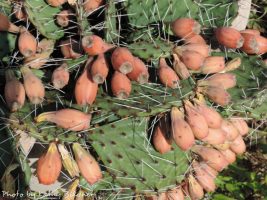
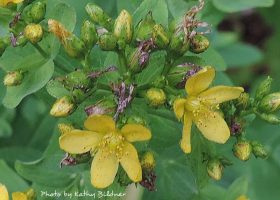
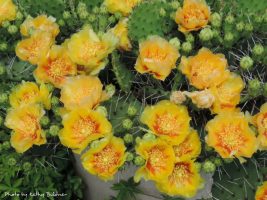
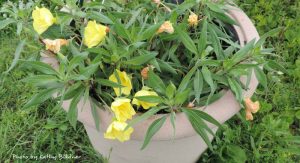
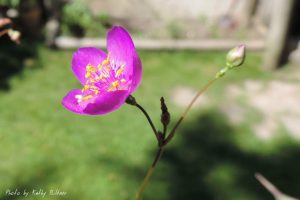
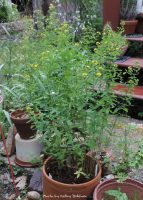
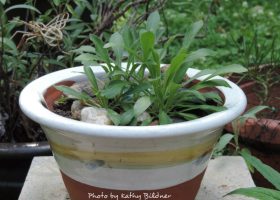
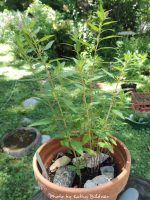
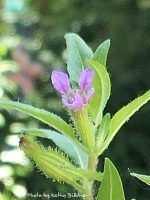
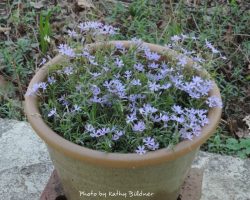
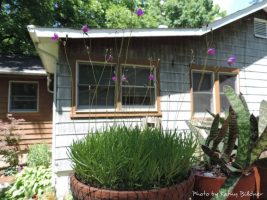

Kathy, thanks for sharing!
I have blue jasmine (Clematis crispa) growing in a pot for the 2nd year and it is very happy.
I am trying to grow coral honeysuckle (Lonicera sempervirens), yellow honeysuckle (Lonicera flava) and trumpet creeper (Campsis radicans) in large pots, also in the 2nd year.
This year, from the SNR sale, I bought fame flower (Talinum calycinum), redwhisker cleome, (Polanisia dodecandra), widow’s cross (Sedum pulchellum), and palafoxia (Palafoxia callosa) and put them in a pot that is mostly sand and rock and they seem happy.
Lovely photos too 🙂
Excellent article. I will try some of your suggestions.
If you click on the photos they will get larger. You can see how I used rocks and a plastic net to keep the squirrels out.
I also have Snow on the Mountain (Euphorbia marginata) in a pot. It just started blooming. Prem had warned me it is aggressive (many seeds), so I thought I can control it in the pot. We will see.
I moved my Aloe (Manfreda virginica) into a pot last Fall. It was lost in taller plants.
It did not bloom this Spring, but it is alive and looks great.
Nice article and photos.
I’m growing Redwiskers, blackberry, wild strawberry, and lizards tail in pots for the opposite reason, to keep them from escaping into the garden.
Wonderful presentation! I’m inspired to try container gardening. Thanks, Kathy.
Thank you!! Great pics.
Kathy, How do you manage the containers in the winter? I put a couple of flame flowers in pots on the patio this spring.